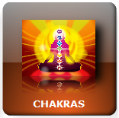 |
||||||
Chakra (derived from the Sanskrit cakraṃ चक्रं ([ˈtʃəkrə̃]), pronounced [ˈtʃəkrə] in Hindi; Pali:chakka ॰हक्क, Tamil: சக்கரம், Chinese: 轮, Tibetan: འཁོར་ལོ་; khorlo) is a Sanskrit word that translates as "wheel" or "turning."[1] Chakra is a concept referring to wheel-like vortices which, according to traditional Indian medicine, are believed to exist in the surface of the etheric double of man.[2] The Chakras are said to be "force centers" or whorls of energy permeating, from a point on the physical body, the layers of thesubtle bodies in an ever-increasing fan-shaped formation. Rotating vortices of subtle matter, they are considered the focal points for the reception and transmission of energies.[3] Different systems posit a varying number of chakras; the most well known system in the West is that of 7 chakras. It is typical for chakras to be depicted as either flower-like or wheel-like. In the former, a specific number of "petals" are shown around the perimeter of a circle. In the latter, a certain number of spokes divide the circle into segments that make the chakra resemble a wheel (or "chakra"). Each chakra possesses a specific number of segments or petals. Texts describing the chakras go back as far as the later Upanishads, for example the Yoga Kundalini Upanishad. |
||||||

